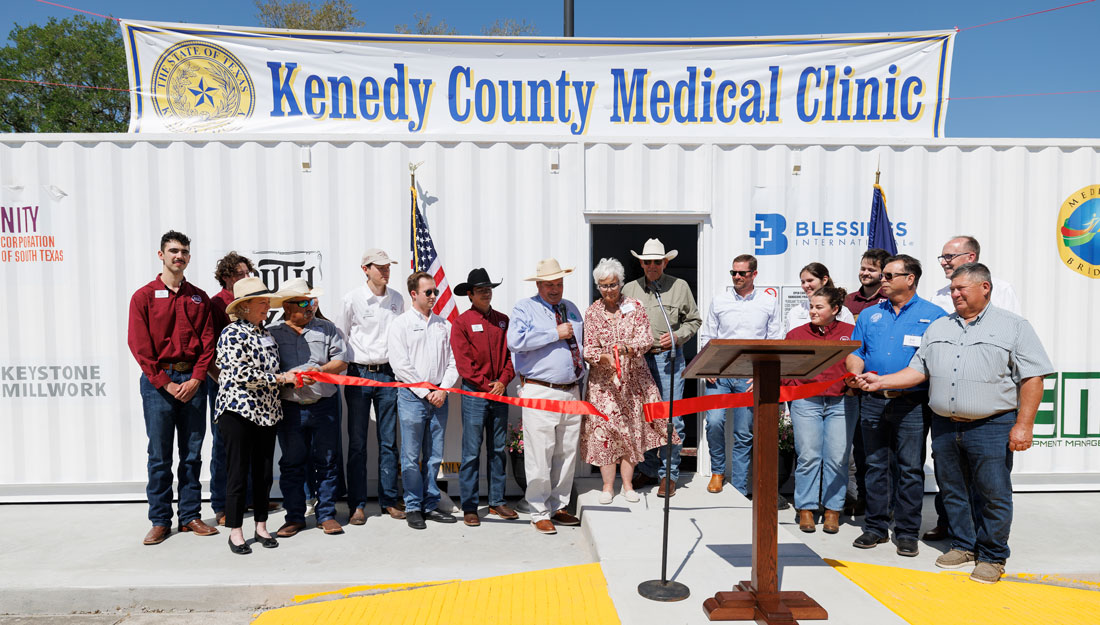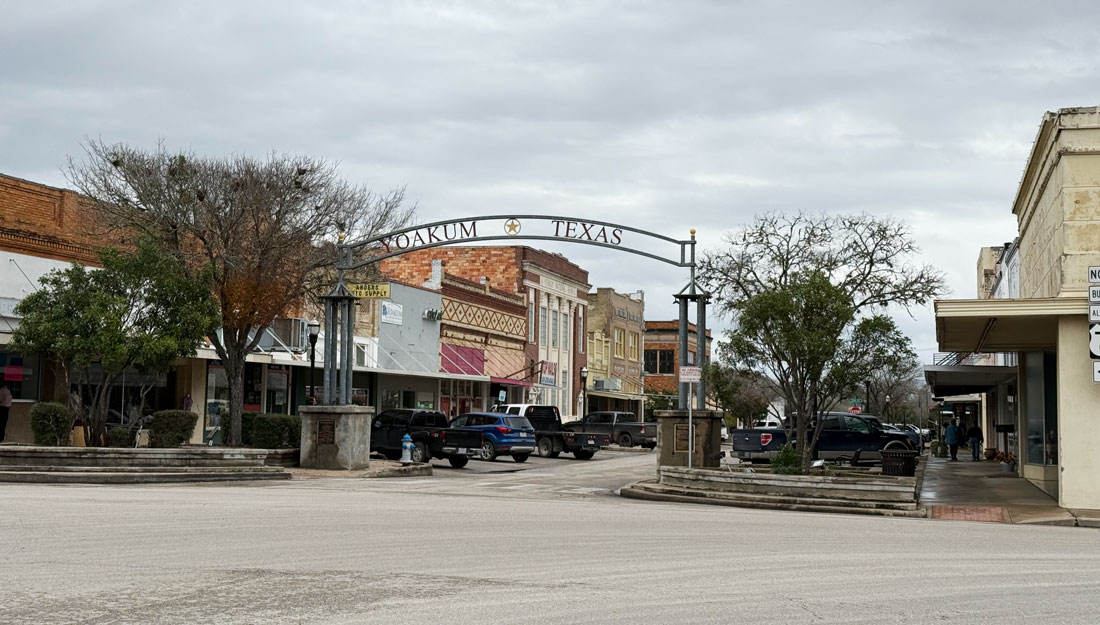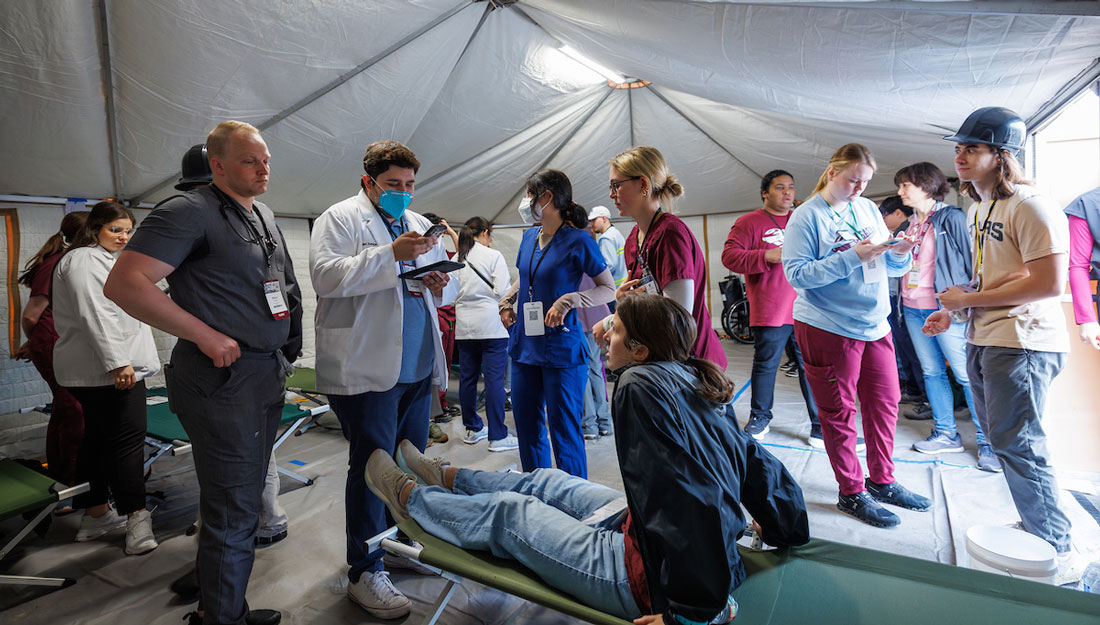- Texas A&M Health Marketing and Communications
- Community, Community Impact, Homepage Featured, Medicine, Show on VR homepage
BUILD brings first-ever medical facility to Kenedy County
Texas A&M University student organization brings container-based and telehealth medical care to Sarita, Texas, in honor of 2nd Lieutenant Clayton Jack Kennedy

The Texas Aggie Medical Clinic is a 40-foot shipping container transformed into a medical facility by the Texas A&M student organization, BUILD. (Abbey Santoro / Texas A&M Division of Marketing and Communications)
Kenedy County dedicated its first health care facility with the unveiling of a BUILD medical container during a ribbon-cutting ceremony in Sarita, Texas, on Wednesday, April 8. The clinic was made possible through a partnership between the Texas A&M University College of Medicine, the Texas A&M Health Telehealth Institute and other collaborators at Texas A&M, along with the Community Action Corporation of South Texas (CACOST).
The new Texas Aggie Medical Clinic (TAMC) will serve Sarita—a town in South Texas so small it has no stop lights—and the surrounding communities both on-site and through a telehealth center housed within the container, allowing some patients to access health care remotely.
“Kicking and screaming, Kenedy County is moving into the 21st Century,” said County Judge Charles Burns, who worked to bring BUILD to Kenedy County—a rural community that spans 2,000 square miles with almost 11 miles of paved roads. “We will now have a doctor’s office in our small community, which is huge for our residents,” he said.
Prior to the TAMC’s dedication, Kenedy County residents had to drive up to 70 miles for medical care, Burns said. He anticipates that the TAMC’s easily accessible location and its telehealth capabilities will help Sarita’s 300 residents and residents of the surrounding counties get the care they need, when they need it.
“It will not require a lot of your time,” Burns said. “You should be able to get in and out and get the care you need expeditiously. That’s big for us—no need not to see the doctor.”
As an advocate for the rural community, Burns called serving its people the driving force behind bringing BUILD to Sarita.
“There’s absolutely no reason why the residents of Sarita and Kenedy County shouldn’t be afforded the same luxury as somebody who lives in a larger town,” Burns said. “Just because we’re small doesn’t mean we don’t have the need. To make Kenedy County healthy again, this should be a great start.”

The container facility will start with primary care and telebehavioral health with the goal of optimizing the facility by bringing in other experts and services to support a healthier community. Plans for the facility include operating hours of at least one day a week to start, said Curtis Donaldson ’81, director of rural medicine outreach at the College of Medicine and director of community engagement in rural Texas for the university. Discussions are even underway, he added, to supplement medical care for the Sarita Elementary School, located just across the street.
Such ongoing teamwork and vision are a natural extension of what brought BUILD to Sarita in the first place, said Carly McCord, PhD, clinical associate professor at the College of Medicine and founding and executive director of the Telehealth Institute.
“At the heart of this project is the strength of relationships,” McCord said. “From the initial vision and the generous donors to the county leadership, medical providers, our students and community partners, it’s the power of collaboration that has made this possible. This clinic is a testament to how much we can achieve when we work together with a shared sense of purpose and a commitment to serving others.”
BUILD began as a Texas A&M student organization in 2013 as a response to the Aggie Bonfire collapse of 1999. Students knowledgeable about the Aggie tradition sought new avenues of creativity and ingenuity to bring Aggie values to life through a “unifying” and “collaborative project.” They began transforming 40-foot shipping containers into fully functional medical clinics, each equipped with spaces for patient triage, laboratory tests and private treatment. The students dedicated the first 12 TAMCs to the Aggies who lost their lives in the Bonfire collapse. In the years since, the organization has continued to deliver TAMCs to communities in need around the world.
The TAMC will mark Kenedy County’s first dedicated health care infrastructure. CACOST Executive Director Ann Awalt said the new facility means families of Kenedy County and nearby communities will be able to receive the care they need without the barriers of distance or availability.
“This project is an example of how innovative solutions can bridge the health care gap in rural Texas,” Awalt said. “By transforming a shipping container into a fully operational medical unit, we are delivering high-quality care in a way that is both practical and impactful. It’s about meeting communities where they are and ensuring they receive the support they deserve.”
Wednesday’s ceremony featured a ribbon cutting and keynote speakers from Texas A&M Health, CACOST and Sarita. Rick Perry, former United States secretary of energy and former governor of Texas, also spoke at the event. The TAMC was dedicated in honor of 2nd Lieutenant Clayton Jack Kennedy ’98, who was a member of the Fightin’ Texas Aggie Band and the Ross Volunteers, in addition to serving as an infantry officer in the United States Marine Corps before his death on April 8, 2000.
The honor supports BUILD student goals, said BUILD Chief Executive Officer Allyson Bartlett, as the organization looks to empower students to make an impact beyond their studies.
“We are honored to have students show the true meaning of the Aggie spirit and proud of the service work we accomplish together in making health care accessible for underserved communities.”
Media contact: media@tamu.edu


